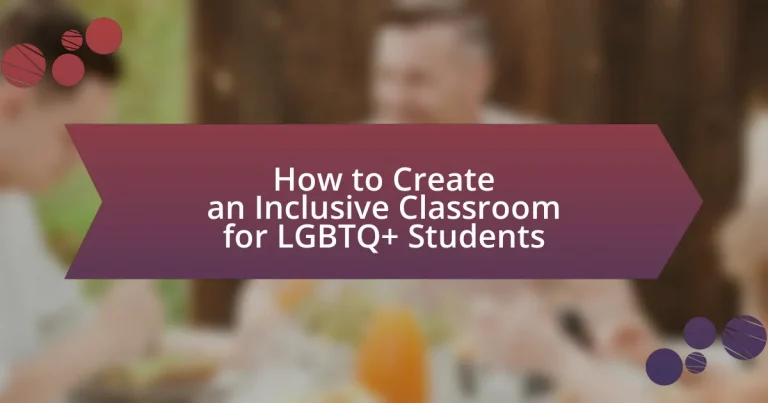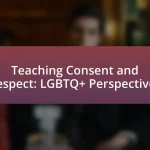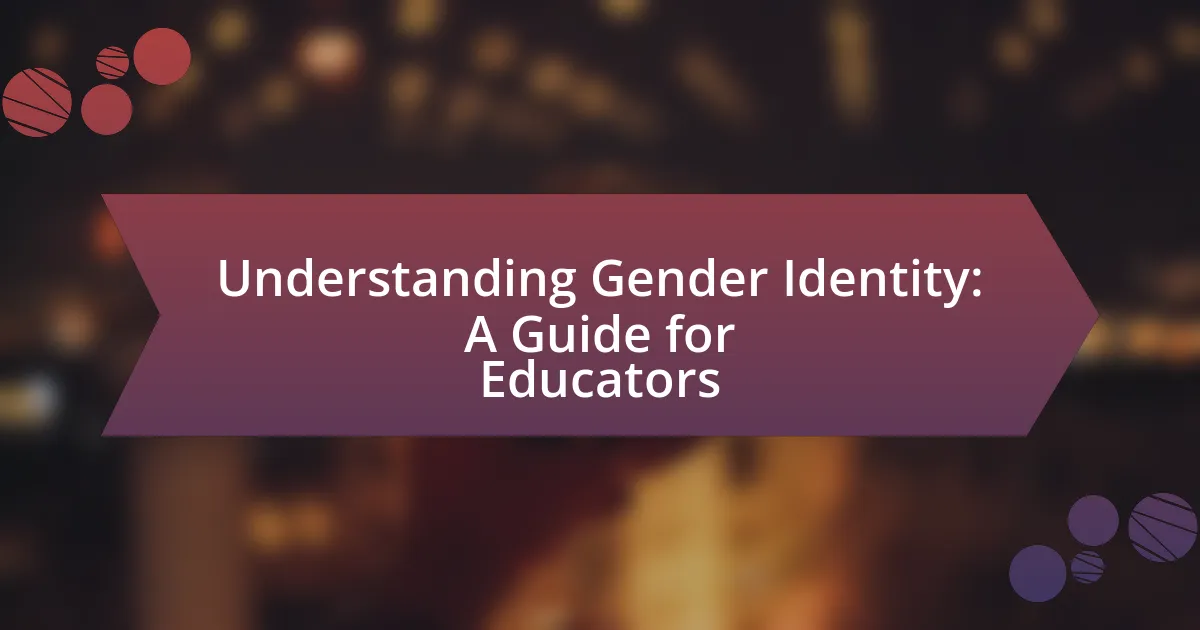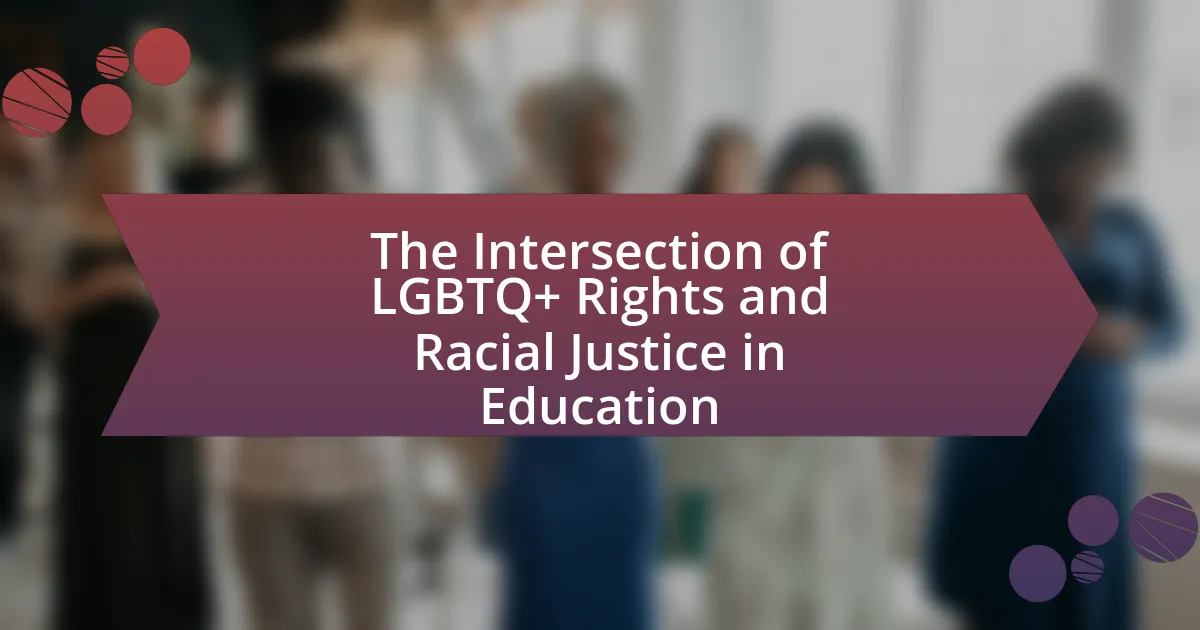Creating an inclusive classroom for LGBTQ+ students involves establishing an environment where all students feel safe, respected, and valued, regardless of their sexual orientation or gender identity. Key principles include implementing anti-discrimination policies, integrating LGBTQ+ topics into the curriculum, and fostering acceptance through education. Research shows that inclusive classrooms lead to improved academic performance and mental health outcomes for LGBTQ+ youth, as they experience lower levels of bullying and higher levels of engagement. Educators can promote inclusivity by adapting curricula, addressing bullying, and providing resources and support, ultimately contributing to a positive school climate and enhanced well-being for all students.

What does it mean to create an inclusive classroom for LGBTQ+ students?
Creating an inclusive classroom for LGBTQ+ students means fostering an environment where all students, regardless of their sexual orientation or gender identity, feel safe, respected, and valued. This involves implementing policies that protect against discrimination, integrating LGBTQ+ topics into the curriculum, and promoting acceptance through education and awareness. Research indicates that inclusive classrooms lead to improved academic performance and mental health outcomes for LGBTQ+ youth, as highlighted in the 2019 report by the Gay, Lesbian & Straight Education Network (GLSEN), which found that students in supportive environments experience lower levels of bullying and higher levels of academic achievement.
Why is inclusivity important for LGBTQ+ students in the classroom?
Inclusivity is important for LGBTQ+ students in the classroom because it fosters a safe and supportive environment that enhances their academic performance and emotional well-being. Research indicates that LGBTQ+ students who experience inclusivity are less likely to face bullying and discrimination, leading to improved mental health outcomes. For instance, a study by the Gay, Lesbian & Straight Education Network (GLSEN) found that schools with inclusive policies and practices reported lower levels of harassment and higher levels of academic achievement among LGBTQ+ students. This demonstrates that inclusivity not only benefits individual students but also contributes to a positive school climate overall.
How does inclusivity impact the mental health of LGBTQ+ students?
Inclusivity significantly enhances the mental health of LGBTQ+ students by fostering a sense of belonging and acceptance. Research indicates that LGBTQ+ students in inclusive environments experience lower levels of anxiety and depression compared to those in non-inclusive settings. For instance, a study published in the Journal of School Psychology found that supportive school climates, characterized by inclusive policies and practices, correlate with improved mental health outcomes, including higher self-esteem and reduced suicidal ideation among LGBTQ+ youth. This evidence underscores the critical role that inclusivity plays in promoting the overall well-being of LGBTQ+ students.
What are the academic benefits of an inclusive classroom for LGBTQ+ students?
An inclusive classroom provides significant academic benefits for LGBTQ+ students by fostering a supportive environment that enhances their engagement and learning outcomes. Research indicates that when LGBTQ+ students feel safe and accepted, they are more likely to participate actively in class discussions and collaborate with peers, leading to improved academic performance. A study published in the Journal of Educational Psychology found that inclusive practices, such as representation in curriculum and supportive policies, correlate with higher grades and lower dropout rates among LGBTQ+ students. Furthermore, inclusive classrooms promote a sense of belonging, which is crucial for motivation and academic success, as evidenced by findings from the Gay, Lesbian, and Straight Education Network (GLSEN) that show LGBTQ+ students in supportive environments report better mental health and higher academic achievement.
What are the key principles of inclusivity in education?
The key principles of inclusivity in education are equity, accessibility, and respect for diversity. Equity ensures that all students receive the support they need to succeed, regardless of their background or identity. Accessibility involves creating an environment where all students can participate fully in learning activities, which includes adapting teaching methods and materials to meet diverse needs. Respect for diversity acknowledges and values the unique experiences and perspectives of each student, fostering a sense of belonging. These principles are supported by research indicating that inclusive educational practices lead to improved academic outcomes and social-emotional well-being for all students, including those from LGBTQ+ communities.
How can educators foster a sense of belonging for LGBTQ+ students?
Educators can foster a sense of belonging for LGBTQ+ students by creating an inclusive environment that actively supports and affirms their identities. This can be achieved through implementing inclusive curricula that represent LGBTQ+ history and contributions, establishing clear anti-bullying policies that protect LGBTQ+ students, and providing safe spaces where students can express themselves without fear of discrimination. Research indicates that schools with supportive environments see improved mental health outcomes for LGBTQ+ youth, as highlighted in the 2019 National School Climate Survey by GLSEN, which found that LGBTQ+ students who felt connected to their school community reported lower rates of bullying and higher academic achievement.
What role does respect and acceptance play in an inclusive classroom?
Respect and acceptance are fundamental in an inclusive classroom as they foster a safe and supportive environment for all students, particularly those from LGBTQ+ backgrounds. When educators model respect and acceptance, they create a culture where diversity is valued, allowing students to express their identities without fear of discrimination. Research indicates that inclusive classrooms, characterized by respect and acceptance, lead to improved academic performance and emotional well-being among LGBTQ+ students, as they feel recognized and validated. For instance, a study published in the Journal of LGBT Youth found that supportive school environments significantly reduce feelings of isolation and increase overall student engagement.

How can educators implement inclusive practices for LGBTQ+ students?
Educators can implement inclusive practices for LGBTQ+ students by creating a safe and affirming environment that respects diverse identities. This can be achieved through the integration of LGBTQ+ topics into the curriculum, ensuring representation in classroom materials, and establishing clear anti-bullying policies that specifically address discrimination based on sexual orientation and gender identity. Research indicates that inclusive curricula can improve the academic performance and emotional well-being of LGBTQ+ students, as highlighted in the 2019 report by GLSEN, which found that students in schools with inclusive policies felt safer and more supported. Additionally, professional development for educators on LGBTQ+ issues can enhance their understanding and ability to support these students effectively.
What strategies can teachers use to create an inclusive environment?
Teachers can create an inclusive environment by implementing strategies such as integrating LGBTQ+ topics into the curriculum, fostering open discussions, and establishing clear anti-bullying policies. Integrating LGBTQ+ topics helps normalize diverse identities and experiences, making students feel represented and valued. Open discussions encourage students to express their thoughts and feelings, promoting empathy and understanding among peers. Establishing clear anti-bullying policies ensures a safe space for all students, as research shows that schools with strong anti-bullying measures report lower rates of harassment and discrimination. These strategies collectively contribute to a supportive and inclusive classroom atmosphere for LGBTQ+ students.
How can curriculum be adapted to reflect LGBTQ+ perspectives?
Curriculum can be adapted to reflect LGBTQ+ perspectives by integrating diverse sexual orientations and gender identities into existing subjects and creating specific content that addresses LGBTQ+ history, literature, and social issues. For instance, including works by LGBTQ+ authors in literature classes and discussing historical figures who identified as LGBTQ+ in history lessons can provide representation and context. Research indicates that inclusive curricula positively impact student well-being and academic performance, as shown in a study by GLSEN, which found that LGBTQ+ inclusive curricula lead to safer school environments and improved mental health outcomes for LGBTQ+ students.
What classroom policies support LGBTQ+ inclusivity?
Classroom policies that support LGBTQ+ inclusivity include anti-discrimination policies, inclusive curriculum, and gender-neutral facilities. Anti-discrimination policies explicitly protect LGBTQ+ students from harassment and bullying, fostering a safe learning environment. An inclusive curriculum integrates LGBTQ+ history and contributions, promoting understanding and acceptance among all students. Gender-neutral facilities, such as restrooms and changing areas, ensure that all students feel comfortable and respected in their school environment. These policies are essential for creating a supportive atmosphere that acknowledges and values diversity, contributing to the overall well-being and academic success of LGBTQ+ students.
How can teachers address bullying and discrimination against LGBTQ+ students?
Teachers can address bullying and discrimination against LGBTQ+ students by implementing comprehensive anti-bullying policies and fostering an inclusive classroom environment. Establishing clear guidelines that explicitly prohibit discrimination based on sexual orientation and gender identity is essential; research indicates that schools with such policies report lower rates of bullying and harassment. Additionally, teachers should engage in professional development to understand LGBTQ+ issues better and incorporate inclusive curricula that reflect diverse identities. Studies show that when LGBTQ+ topics are included in educational materials, students feel safer and more accepted, leading to a decrease in bullying incidents. Furthermore, creating safe spaces for LGBTQ+ students, such as support groups or alliances, can provide them with the necessary support and resources to navigate their experiences.
What are effective interventions for bullying in the classroom?
Effective interventions for bullying in the classroom include implementing anti-bullying policies, promoting social-emotional learning, and fostering a supportive classroom environment. Anti-bullying policies provide clear guidelines and consequences for bullying behavior, which can deter potential bullies. Social-emotional learning programs teach students empathy, conflict resolution, and communication skills, reducing instances of bullying. Additionally, creating a supportive environment where all students feel safe and valued encourages bystanders to intervene and report bullying incidents. Research shows that schools with comprehensive anti-bullying programs see a significant decrease in bullying behavior, highlighting the effectiveness of these interventions.
How can teachers promote allyship among students?
Teachers can promote allyship among students by integrating discussions about diversity and inclusion into the curriculum. This approach fosters understanding and empathy, encouraging students to support one another, particularly those from marginalized groups. Research indicates that inclusive education practices, such as collaborative projects and open dialogues about identity, significantly enhance students’ awareness and acceptance of LGBTQ+ issues. For instance, a study published in the Journal of LGBT Youth found that classrooms that actively engage in discussions about allyship see a 30% increase in students’ willingness to stand up against bullying and discrimination.

What resources are available to support LGBTQ+ inclusivity in classrooms?
Resources available to support LGBTQ+ inclusivity in classrooms include educational materials, training programs, and advocacy organizations. Educational materials such as books and curricula that reflect LGBTQ+ experiences help create an inclusive environment. Training programs for teachers, like those offered by organizations such as GLSEN (Gay, Lesbian & Straight Education Network), provide strategies for addressing LGBTQ+ issues in the classroom. Advocacy organizations, including the Human Rights Campaign, offer resources and toolkits to help schools implement inclusive policies and practices. These resources collectively contribute to fostering a supportive atmosphere for LGBTQ+ students.
What organizations provide support and training for educators?
Organizations that provide support and training for educators include the Human Rights Campaign (HRC), GLSEN (Gay, Lesbian & Straight Education Network), and the National Education Association (NEA). The Human Rights Campaign offers resources and training focused on LGBTQ+ inclusivity in schools, while GLSEN provides professional development and educational resources specifically aimed at creating safe and affirming environments for LGBTQ+ students. The National Education Association supports educators through various programs and initiatives that promote equity and inclusion in education. These organizations are recognized for their commitment to enhancing the educational experience for all students, particularly those from marginalized communities.
How can teachers access LGBTQ+ educational materials and resources?
Teachers can access LGBTQ+ educational materials and resources through various online platforms and organizations dedicated to inclusivity in education. Websites such as GLSEN (Gay, Lesbian & Straight Education Network) provide lesson plans, guides, and resources specifically designed for educators to create inclusive environments. Additionally, the Human Rights Campaign offers educational resources and toolkits that support LGBTQ+ inclusion in schools. Research indicates that integrating LGBTQ+ topics into curricula can enhance students’ understanding and acceptance, as shown in studies published by the Journal of LGBT Youth, which highlight the positive impact of inclusive education on student well-being and academic performance.
What role do community partnerships play in supporting LGBTQ+ students?
Community partnerships play a crucial role in supporting LGBTQ+ students by providing resources, advocacy, and safe spaces. These partnerships often involve collaboration between schools, local LGBTQ+ organizations, and community leaders, which can lead to the development of programs that promote inclusivity and understanding. For instance, research indicates that schools with active partnerships with LGBTQ+ organizations report higher levels of student well-being and lower instances of bullying. Additionally, community partnerships can facilitate training for educators on LGBTQ+ issues, ensuring that staff are equipped to create a supportive environment. This collaborative approach not only enhances the educational experience for LGBTQ+ students but also fosters a culture of acceptance within the broader school community.
What are some best practices for ongoing support of LGBTQ+ students?
Best practices for ongoing support of LGBTQ+ students include creating a safe and affirming environment, providing access to resources, and fostering open communication. Establishing clear anti-bullying policies and training staff on LGBTQ+ issues ensures that students feel protected and respected. Schools should also offer support groups and counseling services tailored to LGBTQ+ needs, which can significantly improve mental health outcomes. Research indicates that inclusive curricula that represent LGBTQ+ histories and contributions can enhance students’ sense of belonging and identity. Additionally, engaging families and communities in discussions about LGBTQ+ issues promotes a broader culture of acceptance and support.
How can teachers create a safe space for LGBTQ+ discussions?
Teachers can create a safe space for LGBTQ+ discussions by establishing clear ground rules that promote respect and confidentiality among students. This approach fosters an environment where students feel secure to express their identities and experiences without fear of judgment. Research indicates that inclusive classroom practices, such as using affirming language and integrating LGBTQ+ topics into the curriculum, significantly enhance students’ sense of belonging and safety (GLSEN, 2020). Additionally, teachers should actively engage in professional development to better understand LGBTQ+ issues and advocate for supportive policies within their schools, further reinforcing a culture of acceptance and understanding.
What ongoing training should educators pursue to remain informed about LGBTQ+ issues?
Educators should pursue ongoing training in LGBTQ+ cultural competency, inclusive pedagogy, and anti-bullying strategies to remain informed about LGBTQ+ issues. This training can include workshops, online courses, and professional development programs that focus on understanding LGBTQ+ identities, addressing biases, and implementing inclusive practices in the classroom. Research indicates that educators who receive training in these areas are better equipped to create supportive environments for LGBTQ+ students, which can lead to improved academic outcomes and mental health for these individuals. For example, a study published in the Journal of LGBT Youth found that schools with trained staff reported lower rates of bullying and higher levels of student well-being.
What practical tips can educators follow to enhance inclusivity for LGBTQ+ students?
Educators can enhance inclusivity for LGBTQ+ students by implementing comprehensive anti-bullying policies that specifically address discrimination based on sexual orientation and gender identity. Research indicates that schools with clear policies see a reduction in bullying incidents and an increase in student well-being. Additionally, educators should incorporate LGBTQ+ topics into the curriculum, which fosters understanding and acceptance among all students. Studies show that inclusive curricula can improve the academic performance and mental health of LGBTQ+ students. Creating safe spaces, such as LGBTQ+ clubs or support groups, also provides students with a sense of belonging and community, which is crucial for their emotional development.





